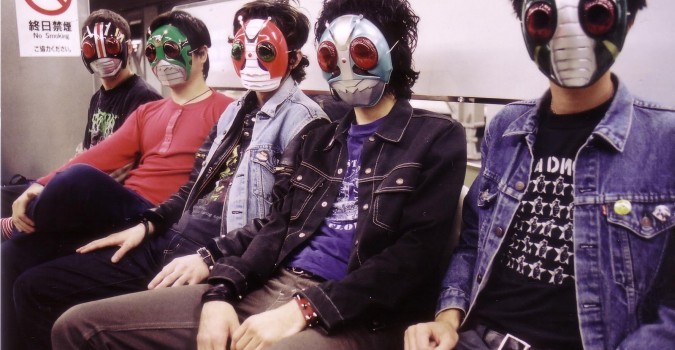The Locust traverse, constantly cross and fuck the line between total chaos and perfect order. Genre-defying and boundary-blurring/destroyers, The Locust are proven to be masters at their craft. What that craft is still proves to be difficult to define Regardless, their lengthy discography speaks for itself.
Emerging from its incubation in 1995, The Locust released its first record: a split 10″ EP with Man Is The Bastard on King of the Monsters, following that up with a split 5″ picture disc with Jenny Piccolo on Three One and then its debut self-titled 7″ on Gold Standard Laboratories. Three years after the release of their 10″ debut, GSL released The Locust’s first full-length, a self-titled, 16-minute-long sonic cataclysm, which sold out the first pressing of 2000 in just a few days. In 2000, a split 7″ with Arab on Radar on GSL was released.
Shortly after this split, The Locust cemented its difficult reputation by putting out a double 12″ of electro/ drum ‘n’ bass remixes of the song “Well I’ll be a Monkey’s Uncle,” on GSL, with folks like Kid 606, I am Spoonbender and Sinking Body turning the song’s crazy noise bursts into even crazier electronic splatter paintings.
The band’s final recording as a five-piece came in 2001 with “Flight of the Wounded Locust” on GSL – a 5 track EP that was rereleased in 2003 on Erika Recrods as a jigsaw record, loaded with an additional 6 tracks.
Showcased for the first time as a four-piece on a split 7″ with Tokyo’s Melt Banana (GSL), Pearson, Karam, Bray and Serbian offer a sound far removed from their grindcore-leaning past. The songs, as a whole, are fast –usually under a minute — brutally ultra-violent and drenched in sci-fi-noise, gruesome insectoid keyboards and herky jerky scream/ sing vocals — described by one journalist as “a car-wreck with vocals.”
After this initial taste as a four-piece, The Locust released Plague Soundscapes on Anti- (a sister label of Epitaph) in June 2003. An album described as “total insanity”, “noise pollution” and “gay” – a completely accurate description. This album solidified the markedly different sonic terrorism The Locust had began to explore – a cataclysm of synths and violent yelps arranged in the most strict and uniform sense. A juxtaposition almost paradoxical.
Almost exactly a year later, The Locust released an archive recording collecting the two tracks found on their split with Jenny Piccolo and the 4th volume of the Cry Now, Cry Later comp.
Safety Second, Body Last soon followed in 2005. A sort of ‘warmup’ for what was to come… This EP proved to be The Locust’s most proficient record so far. As chaotic as Plague Soundscapes, but with menacing, dripping synths during interludes for an ominous piece of sonic obliteration. Swapping out grindcore blastbeats for the most tight-knit, unstable yet completely under control song arrangements recorded, The Locust had found their niche.
New Erections, the band’s latest album, came out two years later in March 2007, perfected what was teased on Safety Second, Body Last. This album fine-tuned everything The Locust had done so well before. New Erections stands out tall as The Locust’s most accomplished record. Sonic structures so complex, vast and intricate it takes more than a couple of listens to ‘get it’. If Plague Soundscapes seemed hard to consume, New Erections is like digesting concrete – if only a little more rewarding.
After lengthy touring following the release of New Erections, The Locust went on hiatus. Another archive recording was released in 2010. This time, a legendary Peel Session recorded 9 years prier in 2001. This 16-track recording was the first time Gabe Serbian had started playing drums for The Locust – finalising the lineup of Bobby Bray, Joey Karam, Justin Pearson and Gabe Serbian that has remained ever since.
Two years on, in 2012, The Locust slowly began to emerge from its periodical cicada to release a remastered and remixed recording of every release The Locust did prior to signing to Anti-. This compilation was called Molecular Genetics From The Gold Standard Labs and, as the title suggest, contains every song The Locust had released with GSL.
It’s clear now that The Locust has started to stir from its slumber…
-Bradley Moore
